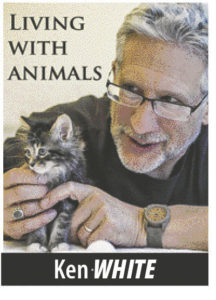For months now, our little Lola (the world’s most adorable puppy) (my column, my rules) has been entertaining us with super-excited mad dashes around furniture, racing from room to backyard to room, wearing a big ear-to-ear grin as she banks the turns, typically landing with a thud in a lap. Recently, she’s added a cyclone-speed whirling dervish assault on her own tail. At barely 10 pounds, there’s not a lot of distance between front and back end and so catching her absurdly long tail wouldn’t be too challenging assuming that was the goal. So if she’s not chasing her tail in order to catch it and teach it a lesson, is this simply a case of getting nowhere fast? Why do dogs chase their tails?
In Lola’s case, we know this to be one silly antic of a silly, healthy, playful puppy, but tail chasing can indeed be a sign of something far less joyful. Boredom: dogs who have nothing to do may resort to tail-chasing to help fill the hours, a sign that more social activity with the family is required. Pain: it sounds counterintuitive, but dogs often chew on painful body parts, sometimes thought of as akin to me rubbing my arthritic ankle. Bugs: both those wormy things on the inside working their way out and external backend fleas, itchy parasites can lead to tail chasing and rubbing a butt along the carpet. OCD: obsessive compulsive behavior in a dog may manifest in obsessive tail chasing, much like obsessive handwashing in our species.
Whirling in tight circles is a normal behavior seen in puppies, dogs with youthful puppy-like approach to life, and even in other wild species of predatory mammals. If an older dog starts chasing the appendage, however, then it’s a good idea to contact your veterinarian to rule out other possibilities. While on the question of canine circles, why do dogs circle prior to laying down and/or pooping? Flattening the grass is the key, harkening back to pre-domestication days. Flattening the grasses creates a soft, level surface before laying down, and allows a better line-of-sight for other dogs to see what’s been “produced”, akin to marking territory. That’s the dogs’ circular thinking!

